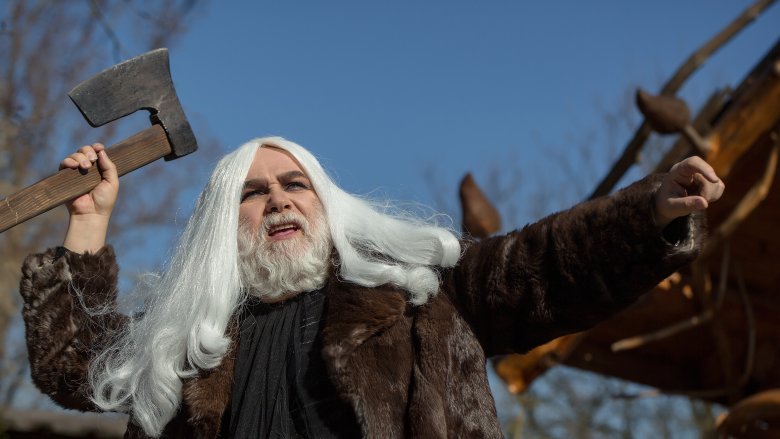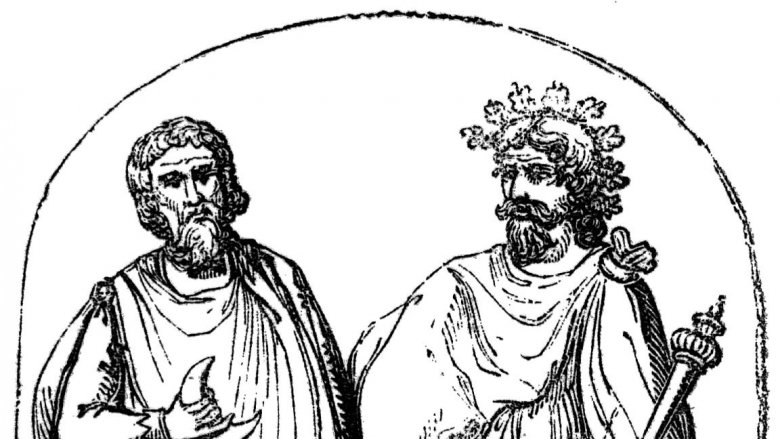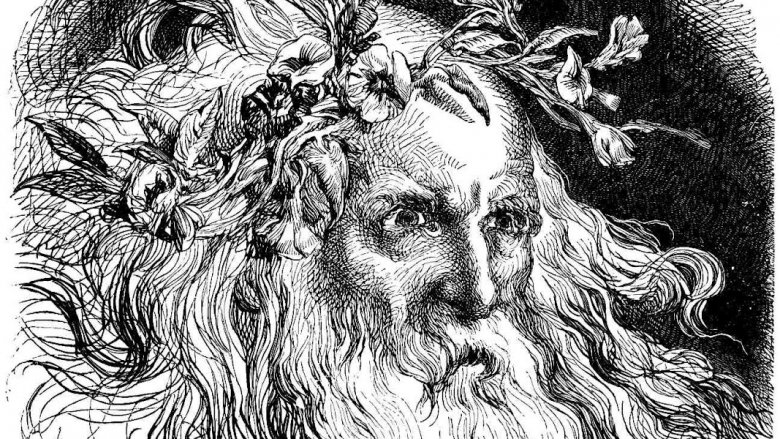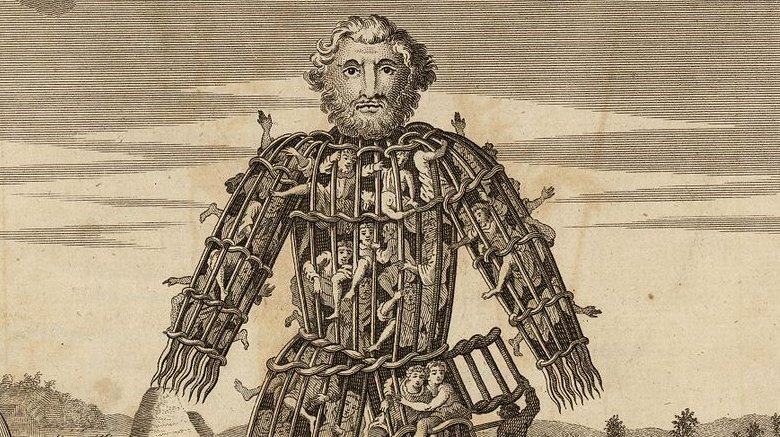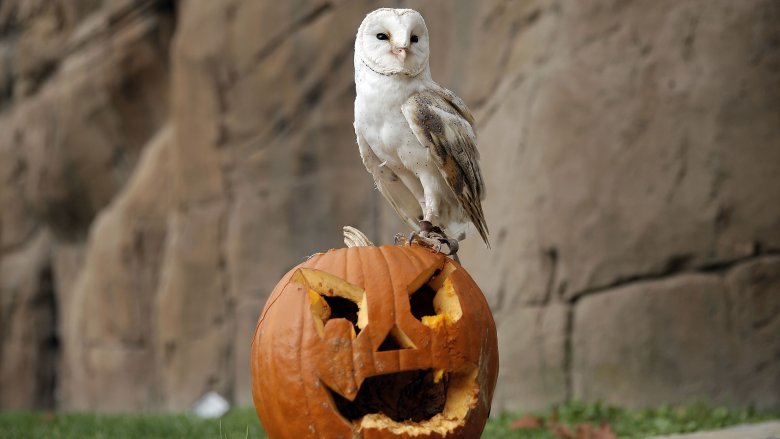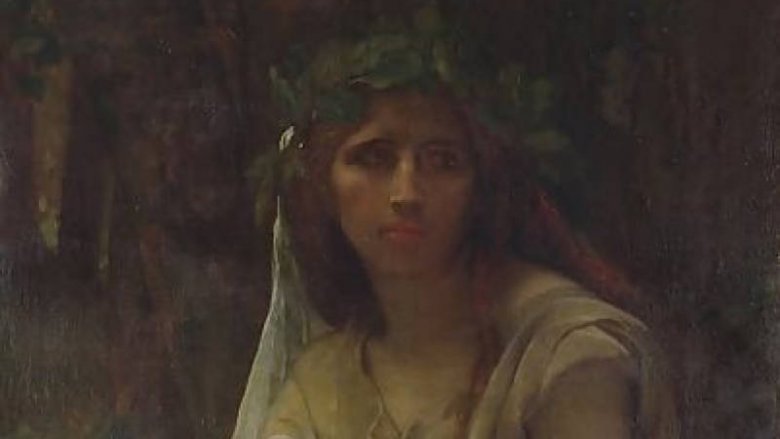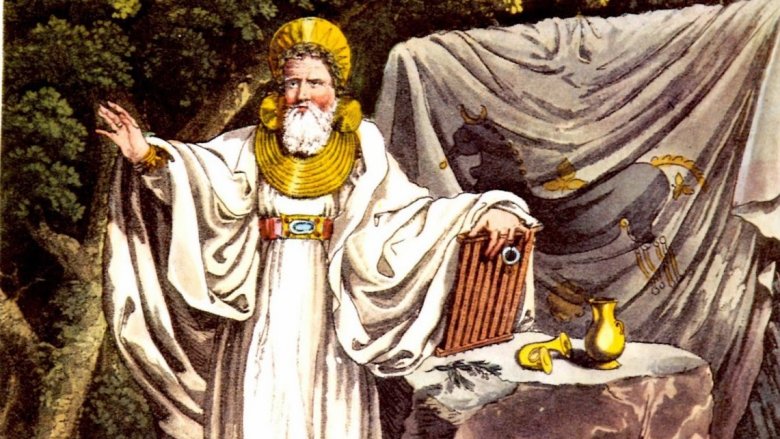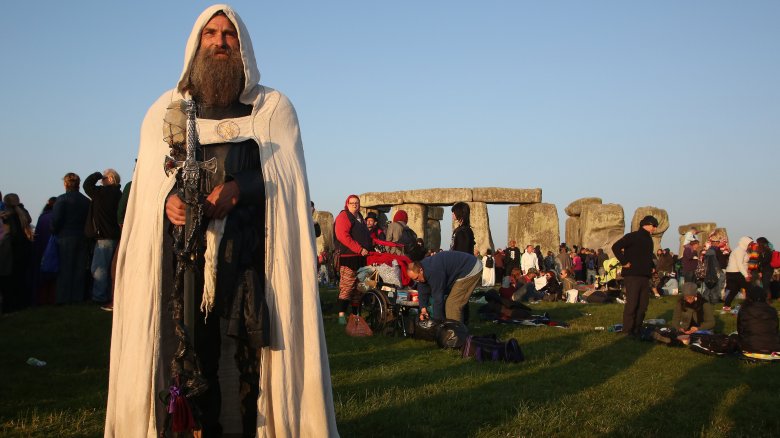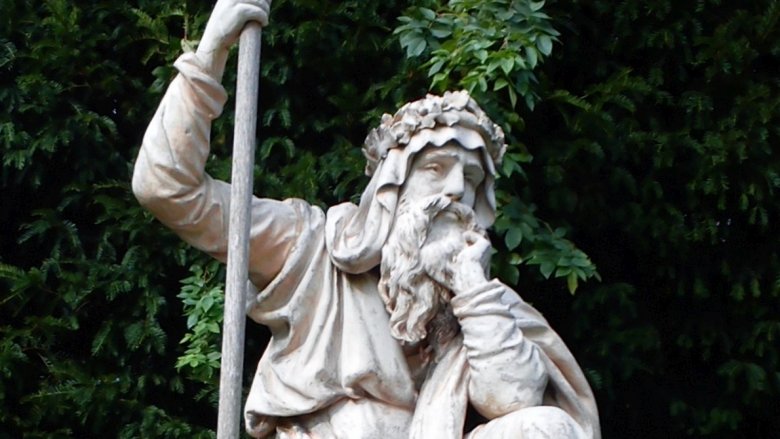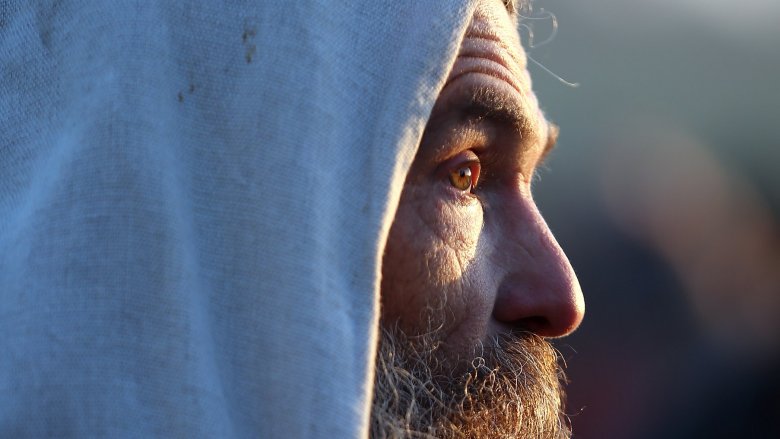False Facts Everyone Believes About The Druids
When you picture a Druid, if you can bring up a picture in your head at all, you likely envision a man with a long white beard, dressed in a long white robe, who probably has a cool talking owl sitting on his shoulder and a staff shooting magic sparks out of it as he constructs a monolithic monument that is a secret astrological calendar—and also he lives in a tree or something. In large part, this image is thanks to depictions in popular culture such as the Druidic class in Dungeons & Dragons or the potion-making healer Getafix from the Asterix series of comics, though part of it also comes from medieval Irish folklore and myth, in which the Druids were mighty wizards battling the Christianization of the Emerald Isle.
In fact, the Druids were a religious and legal class among the ancient Celts who were indeed tied to the natural world (the word "Druid" most likely means "oak-knower") and who eventually encountered the Romans and then disappeared from written record. But much of what we think we know about the Druids comes from a mix of propaganda, mythology, and a modern day revival of ancient beliefs that was itself based on propaganda and mythology.
Let's take a look at some of the most common misconceptions about the ancient priests of Gaul and the British Isles.
That we really know anything at all about Druids
There is a popular saying derived from the works of Plato, which says, "I know one thing, and that is that I know nothing." That is pretty much the mindset you need to be in when you approach the Druids, which is to say, we know basically nothing about them.
According to a lecture by Dr. Ross Wards (hold on to that link, we'll be coming back to it), despite being a literate culture, the ancient Celts had a rule against writing their knowledge down lest it fall into the wrong hands, so everything was passed down orally and learned by heart. As a result, there are no first-hand subjective accounts of the ancient Druids. More or less the only ancient information we have about them comes from Roman writers such as Julius Caesar, who was there to conquer and subdue the people of Gaul and Britain, and Pliny the Elder, who attributes the wiping out of the Druids to the emperor Tiberius.
Wards asserts that the Roman reason for wanting to both destroy the Druids and skew the historical record of them was not because of hideous rituals they performed (more on that later), but because when you want to subdue a culture, the first thing you need to do is put down their cultural and intellectual leaders. So since much of what we "know" about Druids comes from their enemies, the Romans, it's important we take a lot of that with a grain of salt.
They were (just) religious leaders
The word Druid in modern times has become almost synonymous with "pagan priest" or the like, with the idea being that they were holy men, like shamans, with a mystical connection to the natural world and who performed strange rituals and spoke for the trees like they were the Lorax or something. While it is true that the Druids were a religious class among the ancient Celts, the fact is they were also much more.
According to Caesar's account, the Druids were one of two esteemed social classes among the Celts, with the other being the equites (knights or noblemen). The Druids were not only priests, performing both public and private sacrifices, they also served a judicial role, arbitrating disputes and issuing punishments. Additionally, they were teachers, studying such topics as philosophy, astronomy, science, and religion, and then passing that information on to others via oral tradition (writing was prohibited, remember?). It could take up to 20 years of study to become a Druid, which seems like a lot, but presumably there were no student loans to pay off afterwards, so it kind of balances out. Another plus is that Druids didn't have to serve in the military or pay taxes.
Additionally, Druids would have been political advisors and even the chiefs of some Gallic tribes, and they would have also been trained in the medical arts, though it is not likely they were crafting super-strength potions like Getafix. In short, the Druids were basically living storehouses for all human knowledge.
They built Stonehenge
Just about everyone is familiar with the megalithic monument on the Salisbury Plain, Stonehenge, the UNESCO World Heritage Site where a man is a man and the children dance to the pipes of Pan. But was this world famous landmark in fact, as Spinal Tap's Nigel Tufnel claims, built by the Druids, "in ancient times, hundreds of years before the dawn of history"?
Well, in short: no. (You may be thinking, "If Spinal Tap is wrong about this, what else might they be wrong about?" Don't panic; you'll just have to soldier on.) According to the History Channel, the idea that the Druids built Stonehenge began with 17th century archaeologist John Aubrey and was then popularized by antiquarian William Stukeley. The idea has taken such a firm root in popular consciousness that even today, modern people who identify as neo-Druids gather at Stonehenge to celebrate the solstice.
But as with many cool ideas, science ruins this theory: radiocarbon dating shows that the stones of Stonehenge stood on Salisbury Plain more than a thousand years before the Celts came to the British Isles from continental Europe. The monument was likely built by a number of successive tribes native to Britain, beginning with some Stone Age farmers.
Regrettably, this definitely rules out another, even more awesome theory for the origin of Stonehenge; namely, the claim by Geoffrey of Monmouth that Stonehenge was magically built by Merlin with stones stolen from giants to be a mass grave for Britons killed in battle with the Saxons.
They made human sacrifices inside a giant wicker man
All right, this is a tricky one. Caesar reports somewhat famously that the Druids would perform human sacrifices by building a giant man out of twigs, filling that man with people like a terrifying pinata for Brobdingnagians, and then burning it to the ground. This has been a fairly resonant image for people, inspiring one of the all-time greatest horror films, The Wicker Man (the 1973 original, not the 2006 one with Nicolas Cage and bees). Pliny the Elder would go even further in his claims, stating that the Druids practiced ritualized cannibalism, believing they gained strength from consuming the flesh of their enemies.
In more modern times, some (including and especially neo-Druids) would claim that this was nothing but anti-Druid propaganda on the part of the Romans and that there is no archeological evidence of human sacrifice in Ireland. Does archeology bear this out? Well: no. There is, in fact, quite a bit of evidence of human sacrifice by the Druids, not the least being a man who had been strangled, been conked on the head, and then had his throat slit, a practice known as the "three-fold death" in later writings.
But! Were these sacrifices carried out in a wicker man? Probably not. As Gerald B. Gardner points out, the first thing that would happen is that the burning man would fall over and everyone would get out. There is evidence of wicker men in Celtic culture, but they would have been images used for processions and other (non-murdery) religious purposes.
Samhain was one of their gods
You hear it from every edgelord you know as Halloween approaches: our cute little candy and goblin holiday was originally a celebration of Samhain, the Celtic God of the Dead, and it is serious business that is not for babies. Or maybe this was the reason your religious mother didn't want you to go trick or treating (obviously a pagan ritual celebrating death) and you had to dress like a Bible character at your local church's "Fall Festival" instead.
Well? Did the Druids worship a death god named Samhain in October times? Nah, man. This misconception has its roots in a book from 1770 by a dude named Col. Charles Vallency who wanted to prove the Druids came from Armenia for some reason. So what is Samhain, actually? The word Samhain just means "summer's end," and represents a shifting of the seasons from summer to winter, kind of a New Year's Eve. It's not a deity, it's a holiday, like Imbolc, Beltane, and Lughnasadh.
Also, you're almost certainly pronouncing it wrong. It's very easy as an English speaker to look at that and say it like it's spelled—"sam hane"—which happens in tons of TV shows and movies about Halloween. But in Irish, that "mh" letter combo is pronounced in most places like a w, so a better approximation of how it's said is "sow-in," with "sow" rhyming with "cow." Now you know, and you can lord that over your friends.
They were all male
Now let's look at a few details of how the Druids are imagined in popular conception. As Wards puts it, many people imagine Druids as "ascetic celibate priests wearing long white beard and long white robes." Admit it: it's what you've been picturing this whole time you've been reading this article. And no wonder: it's what's popularly depicted in art, even that going back some centuries.
The reason that depictions of Druids have been traditionally male is likely due to the fact that the classical sources (Caesar and his boys) don't mention any female Druids, probably because they themselves came from a male-dominated society. Wards points out, however, that Druids believed in equality between men and women, as shown by their roles as Druids, warrior-queens (like Boudica), and ambassadors.
Further evidence of female Druids comes from the fact that, well, there were multiple words for "female Druid" in the Irish language, including, but not limited to, the word bandruí, which literally means "woman Druid." Furthermore, we know the names of specific (admittedly mythological) female Druids. Women Druids pop up in later Irish literature, such as Bodhmall, a Druidess who was a caretaker of Fionn Mac Cumhaill, who was basically the Irish Hercules, and also Tlachtga (yes: Irish is a wild language), daughter of another Druid and herself closely associated with the celebration of Samhain.
They wore white robes
The traditional image of a Druid in a long white robe comes about as the result of a mistranslation. In a passage describing the importance of the oak tree and mistletoe to Druidic religion, Pliny the Elder describes the priest climbing the tree as a "sacerdos candida veste cultus," (go ahead: check the Latin if you want), which has been translated as "priest clad in a white robe." However, the Lewis and Short Latin Dictionary shows that the word translated as robe is actually a more generic term for clothing rather than a robe specifically. So what we know then is that Druidic priests wore white clothes of some kind, specifically when they were climbing a tree to gather mistletoe.
The Llewellyn Encyclopedia reports that most likely the Druids wore white tunics and cloaks rather than robes. Additionally, Druids were known to carry rods made of straight white wood and gilded as a sign of their office, and to wear cloaks made of gray or white bull hide. The fact that many Druids seem to have received the nickname Mael, meaning "bald," indicates that the Druids may have traditionally worn the tonsure later common among Christian clerics in Ireland. This was distinguished from the tonsure worn by monks elsewhere (picture Friar Tuck; it's that haircut that makes you look like you have a huge bald spot) by instead being clipped from ear to ear along the hairline, making you instead look like you have a huge forehead rather than a bald spot.
They were monotheistic
As with most things, we don't know a ton about what the Druids actually believed. Wards points out that one of their major beliefs is in the immortality of the soul; namely, that like diamonds, souls are forever, and if you die, your soul just reincarnates in another body. They also believed that the soul resided in the head rather than the heart, which is actually surprisingly advanced if you think about it. How many people still think of the heart as the seat of emotion and spirit when by now science has shown that stuff is all just chemicals in the old brain box?
That said, there is a current of belief that the ancient Druids were monotheistic, practicing a kind of proto-Christianity. This, however, has its roots in the modern revival of Druidism in the 18th century. The closeness to nature of the Druids would have appealed to the Romantic sensibility of that time, but the huge preponderance of Christianity throughout Europe would influence these neo-Druids to fuse their own religious beliefs with their imagined conception of the ancient one.
The Celts were in fact super polytheistic, believing in, as Wards points out, the mother goddess Danu, her children the Tuatha de Danaan, the sun gold Belenus, and various triune gods and goddesses, which probably helped prime them to understand the Trinity when Saint Patrick came along with his shamrock metaphor.
They were celibate
As Wards points out, the popular image of Druids is of bearded ascetics, and one of the additional elements of that is the idea of celibacy. This is a claim that is further spread by the book The 21 Lessons of Merlyn, which alleges to be based on a never-before-published manuscript of Druidic teaching called The Book of Pheryllt. However, as writer Mary Jones points out, The Book of Pheryllt is totally fake. She also makes a point-by-point rebuttal of many of the claims of the book, so feel free to check that out, but know that there is some colorful language in there.
One of the things Jones points out is that Druids were definitely not celibate, either in history or in legend. For one thing, there are stories of Druids who are children of other Druids (remember Tlachtga from a minute ago? Who could forget a name like that?), and King Conchobhor mac Nessa of Ulster was said to be the son of the Druid Cathbad. Furthermore, as Wards says, they were a hereditary caste: if they didn't get married and have children, there would be no more Druids.
They were from Atlantis
Okay, look, fair enough. This is certainly not a fact that everyone believes, because obviously some of you are very smart and read our article on the history of Atlantis and know that Atlantis is a metaphor and not a real place, so only metaphorical people can come from there. But if you read that article, you also know that a little thing like facts never stopped notable crackpot Ignatius Donnelly, who claims in his book Atlantis, the Antediluvian World that the Druids, and indeed, a large number of Irish races and classes came from Atlantis. The idea took root enough that it is part of The 21 Lessons of Merlyn as well as being widespread enough that the modern Druidry website acknowledges that it is a thing that some people believe.
Since you obviously already know that this one is fake, here's another question: what happened to the Druids? Aside from being systematically wiped out by the Romans, Wards suggests that they probably just assimilated with Christians once those dudes showed up. The fact that there aren't any Irish martyrs from ancient times shows that it was a pretty peaceful transition, despite the fact that medieval Irish literature shows the Druids as powerful wizards resisting Christianity tooth and claw. Their holy wells became Christian holy wells, their tonsure became the Christian tonsure, and so on. In this way, it's not impossible to imagine that a bit of the ancient Druids still survive with us today.
